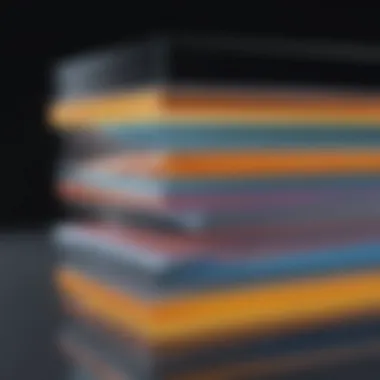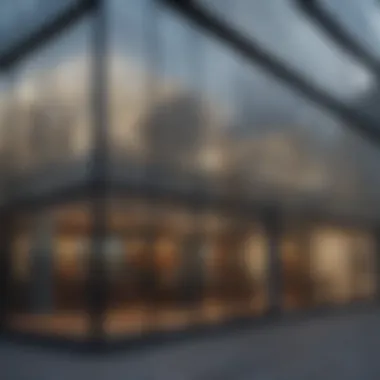Unlocking the Potential of Reflective Film Technology


Intro
The realm of reflective films encompasses a fascinating intersection of science and practicality. These films have gained considerable importance across various sectors due to their unique properties. Their reflective qualities allow for significant energy savings, safety implementations, and aesthetic enhancements in both construction and vehicle design. Understanding the mechanisms behind these films opens up opportunities for innovative applications that not only improve efficiency but also contribute positively to environmental sustainability.
As we delve into this comprehensive analysis, we will explore the fundamental aspects of reflective films, including their composition and functionalities. This article aims to highlight ongoing advancements in this field, particularly the technological innovations that are enhancing the capabilities and applications of reflective films. Additionally, we will discuss the challenges faced by industries in the production and application of these materials, as well as trends that are likely to shape their future development.
Prelude to Reflective Film
Reflective film plays a crucial role in various modern applications. Its significance extends beyond mere visibility; it impacts safety, aesthetics, and energy efficiency across several sectors, including automotive, construction, and electronics. The first step in understanding these diverse applications is to grasp what reflective film really is and the key attributes that define it.
Definition and Key Characteristics
Reflective film consists of a thin layer material designed to reflect light. Its primary purpose revolves around enhancing visibility during low-light conditions, thereby improving safety. Key characteristics of reflective film include:
- Reflectivity: The ability to bounce light back efficiently. High-performance reflective films can offer up to 90% reflectivity.
- Durability: A good reflective film must withstand environmental factors such as moisture, UV radiation, and temperature fluctuations.
- Flexibility: Many reflective films can adhere to various surfaces without losing their reflective properties. This allows for broad applications that are adaptable across industries.
Understanding these characteristics is essential for evaluating how reflective film can be effectively utilized in practical scenarios.
Historical Context
The development of reflective film has a rich history that dates back to earlier technologies aimed at enhancing visibility. Initially, reflective materials emerged from the need to improve safety on roads and high-traffic areas. In the 1930s, the introduction of glass beads in paint marked the beginning of modern reflective systems, allowing vehicles and pedestrians to be more visible at night.
Over the decades, innovations have led to varied advancements in the types of reflective films available today. As urban environments expanded and technology evolved, reflective films started integrating into various products. The exploration of options such as microprism technology further broadened the functional scope of these materials.
This historical insight demonstrates that reflective film is not just a modern innovation but rather a product of continuous evolution and adaptation to societal needs and technological advancements.
Composition of Reflective Film
The composition of reflective film is vital for understanding its properties and applications. Each material used plays a significant role, influencing performance, durability, and usability. This section will analyze the key materials and manufacturing processes behind reflective films, demonstrating their respective contributions to the overall functionality.
Materials Utilized
Polyester
Polyester serves as a primary material in the production of reflective films. This synthetic fabric has excellent durability, resilience, and flexibility, making it a popular choice in many applications. One notable characteristic of polyester is its ability to withstand various environmental conditions. It remains stable when exposed to UV light, preventing degradation over time.
The unique feature of polyester includes resistance to mildew and high temperatures. This quality is advantageous for outdoor applications, where materials face challenging weather. However, polyester is not biodegradable, which raises concerns about its environmental impact.
Glass Beads
Glass beads are another essential component in reflective films. They act as prisms, capturing and reflecting light back towards its source. This unique aspect enhances the visibility of the reflective film, especially in low-light conditions. A key characteristic of glass beads is their ability to create a high level of brightness when illuminated by headlights. This makes glass beads a beneficial choice for safety gear and traffic signs.
One of the advantages of using glass beads is their transparency which allows for vibrant graphics underneath the coating. However, glass beads are more prone to wear and tear, leading to the gradual loss of reflective qualities if not properly maintained.
Microprism Technology
Microprism technology represents an advanced method in reflective film design. This technology uses precisely arranged microprisms to enhance light reflection. The key characteristic that sets microprism technology apart is its efficiency in reflecting light over a wide range of angles. This feature is particularly advantageous in applications such as vehicle safety features, where visibility from varying angles is crucial.
Microprism technology offers greater durability compared to traditional methods, as it can withstand harsh conditions without significant performance degradation. However, the complexity of manufacturing microprism films can increase production costs, which is a consideration for manufacturers.
Manufacturing Processes
Coating Techniques
Coating techniques play a significant role in the creation of reflective films. These processes involve applying a reflective coating onto a substrate, which can enhance the film's reflective properties. A key characteristic of these techniques is the ability to customize coatings according to specific application needs. This flexibility allows for a wide range of end products, from safety gear to decorative films.


An advantage of coating techniques is the ability to produce films with varied finishes and textures, enhancing aesthetic appeal. However, the effectiveness of the coating can be affected by environmental factors, requiring careful consideration during the application process.
Printing Methods
Printing methods are critical in creating visual designs on reflective films. Techniques such as screen printing and digital printing enable manufacturers to apply intricate designs without compromising the reflective qualities of the film. The primary characteristic of these methods is the precision with which designs can be applied. This is particularly beneficial in creating customized products for specific industries.
An advantage of using advanced printing methods is the capability to produce high-quality graphics that are durable and long-lasting. Nevertheless, maintaining the reflective properties while applying decorative prints can be challenging, necessitating ongoing research and development in this area.
Mechanics of Reflective Film
Understanding the mechanics of reflective film is paramount for grasping its applications and implications across diverse fields. This segment delves into the foundational concepts of how reflective films operate, enabling efficient utilization in practical scenarios. Key elements such as the principles of reflection and their optical properties define the efficacy of these films. A comprehensive grasp of these concepts allows engineers, designers, and researchers to innovate and improve existing technologies. The application of reflective films in various industries largely hinges on these mechanical properties, making them a focal point of study and development.
Principles of Reflection
Reflective films function based on fundamental principles of reflection. When light strikes a reflective surface, it interacts in two major ways: absorption and reflection. The ratio of light that is reflected versus absorbed largely determines the effectiveness of the reflective film.
The basic concept involves the angle of incidence—where light hits the surface—and the angle of reflection, which can be influenced by the film’s composition and surface structure. The critical properties here include:
- Law of Reflection: This law states that the angle of incidence equals the angle of reflection.
- Surface Smoothness: Smooth surfaces such as those with glass beads tend to provide better reflective properties compared to rough surfaces.
- Layered Structures: Some reflective films utilize a layering of materials to enhance their reflective capabilities. This is crucial in various applications, making them suitable for a range of products from safety gear to decorative elements in architecture.
Understanding these principles not only enhances the design of reflective films but also informs their strategic use across different industries, helping to meet specific requirements like energy efficiency, safety, and visibility.
Optical Properties
The optical properties of reflective films play a significant role in determining their performance. These properties include:
- Reflection Coefficient: This measures how much light is reflected by the film. Higher values indicate better reflectivity, influencing the effectiveness of the film in applications like traffic signs and safety equipment.
- Color Stability: Reflective films should maintain color do consistency over time, especially when subjected to environmental factors. This stability is vital in products that require longevity and aesthetic appeal.
- Transmittance: While the primary purpose is to reflect, understanding how much light is transmitted through the film can also inform its usability in certain contexts. Films that balance these properties effectively are highly sought after.
Effective optimization of these optical characteristics can significantly enhance the utility of reflective films. Different applications may prioritize different aspects, such as high reflectivity for safety equipment versus color stability for decorative uses. Engineers focus on these traits to ensure that reflective films meet the demands of their intended application and continue to evolve with technological advancements.
"The importance of understanding the mechanics of reflective film cannot be overstated; it is essential not only for developing existing technologies but also for paving the way for future innovations in various fields."
Applications of Reflective Film
The applications of reflective film are vast and varied. These films are used in different industries which include consumer products, automotive, construction, and electronics. Each application brings unique benefits, reflecting the film's versatility. As energy efficiency and safety become increasingly important in society, the role of reflective film is more critical than ever. It enhances visibility, protects materials, and contributes to better energy management.
Consumer Products
Reflective Apparel
Reflective apparel has wide-ranging uses, primarily in safety and visibility. It is often worn by cyclists, construction workers, and others whose job requires them to be visible in low light conditions. A key characteristic of reflective apparel is its ability to reflect light, making wearers more visible to approaching vehicles. This feature significantly reduces the risk of accidents in poorly lit environments. Reflective apparel is a popular choice because it combines functionality with comfort.
One notable aspect is the lightweight materials that do not hinder movement. However, some might find the reflective elements can wear out over time, particularly with frequent washing. Despite this disadvantage, the benefits in visibility often outweigh the downsides.
Safety Gear
Safety gear that incorporates reflective film is crucial across various work environments. It enhances the wearer’s safety by increasing visibility, particularly in hazardous conditions. The key characteristic is its integration with durable materials that meet safety standards. This makes it a preferred choice for high-risk jobs, such as in construction or road maintenance.
The unique feature of reflective safety gear lies in its reflective properties that are required for day and night use. It can be a bit bulky, which some users might dislike. However, the protection offered is paramount, making it an indispensable tool in many workplaces.
Automotive Industry
Traffic Signs
Reflective films are essential for traffic signs. They enhance legibility and visibility, especially at night or in poor weather conditions. The key characteristic is that these films increase the brightness of the signs when illuminated by headlights. This attribute ensures that drivers can recognize traffic signs from a distance, reducing the risk of accidents.
The unique feature of reflective traffic signs is their durability. They are designed to withstand harsh weather conditions without losing effectiveness. However, over time, exposure to UV light can degrade the materials. Still, the advantage of increased safety for road users is significant, making it a popular choice.


Vehicle Safety Features
Reflective films are also used on vehicles. They play a role in enhancing safety through visibility features like reflective decals or strips. These features help make vehicles more noticeable, particularly in low-light situations. The key characteristic of these safety features is their ability to be applied in various forms to suit different vehicle types.
A unique aspect is that they can be customized for different designs, aligning with branding priorities. While highly effective, some films can become dirty, diminishing visibility unless maintained properly. Regardless, vehicle safety enhancements through reflective films are undeniable.
Construction and Architecture
Insulation Materials
Reflective films are important in insulation materials. They are designed to reflect radiant heat, improving energy efficiency in buildings. The key characteristic is their ability to reduce heat transfer, which directly impacts energy consumption. As energy costs rise, these materials become more beneficial for builders and homeowners alike.
One unique feature is the incorporation of reflective materials into attic areas to optimize insulation. While the initial installation cost may be higher, potential energy savings often justify the investment over time. The challenge remains in ensuring proper installation to maximize effectiveness.
Decorative Facades
In construction and architecture, reflective films are increasingly used for decorative facades. These films can enhance the aesthetic appeal of buildings while also reflecting sunlight. The key characteristic is their ability to provide a modern look while also serving functional purposes, such as reducing heat intake.
A unique feature of decorative facades is their versatility in design, offering numerous colors and patterns. Some may worry about durability against weather changes, but advancements in technology have improved this significantly. The balance of design and function makes them widely accepted in new architecture projects.
Electronics and Displays
Screen Protection
Reflective films are used in screen protection, particularly for smartphones and tablets. They safeguard against scratches and impacts while maintaining high visibility under light. The key characteristic is the enhanced durability these films add to devices.
A unique feature is the clarity that modern reflective screen protectors provide. Although some users report a change in touch sensitivity, many find it acceptable in exchange for added protection. The benefits in prolonging the lifespan of devices resonate with a wide audience.
Lighting Solutions
Reflective films play a crucial role in lighting solutions, enhancing the efficiency of light fixtures. The key characteristic of reflective films used in this area is their capability to direct light in specific ways, increasing overall illumination.
An important feature is their impact on energy efficiency, as they assist in maximizing light output. However, some materials can be susceptible to yellowing over time, which may reduce efficiency. Fortunately, technological advancements continue to mitigate such concerns, keeping reflective films relevant in the lighting sector.
In summary, reflective films contribute significantly to their respective industries, improving safety, aesthetics, and energy efficiency. Their evolution and continued innovation will likely expand their utility even further.
Innovations in Reflective Film Technology
In the rapidly evolving field of reflective film technology, innovations play a crucial role in enhancing functionality and expanding applications. The advancements in this area not only improve the performance of reflective films but also address various industry needs, such as energy efficiency, safety, and aesthetic value. Understanding these innovations is essential for recognizing how reflective films can be utilized in contemporary and future scenarios.
Nano-Reflective Films
Nano-reflective films exemplify a cutting-edge development in the reflective film landscape. These films leverage nanotechnology to achieve remarkable optical properties. The incorporation of nanoparticles into the film matrix enables enhanced light management.
This technology provides several advantages, including superior light reflectivity and durability compared to traditional films. The key characteristic of nano-reflective films is their ability to manipulate light at a microscopic level, which increases efficiency in various applications, from solar devices to automotive safety enhancements.
Despite their potential, there are considerations to be aware of, including higher production costs and possible environmental impacts. Nevertheless, ongoing research aims to mitigate these challenges, paving the way for broader adoption of nano-reflective films in industry.
Smart Reflective Coatings
Smart reflective coatings represent another significant advancement. These coatings can adapt to environmental conditions, providing versatility and enhanced performance.
Color Changing Films
Color changing films are a prominent feature of smart reflective coatings. They can alter their color in response to specific stimuli, such as light intensity or temperature. This unique characteristic enhances functionality in various applications, including smart windows and automotive displays.
The benefits of color changing films include energy savings through better temperature regulation and improved aesthetic appeal. However, the technology may face challenges such as durability and cost, making it essential for manufacturers to balance performance and affordability.


Photovoltaic Integration
Photovoltaic integration in reflective films marks a significant step forward in renewable energy applications. This technology enables the conversion of light into electricity while maintaining reflective properties. The key characteristic lies in its dual function as both a reflective surface and an energy-generating component.
Photovoltaic integration is valuable for sustainable energy solutions, particularly in building designs where maintaining visual appeal while harnessing solar energy is crucial. Though the technology may be more expensive initially, it holds the promise of long-term savings and significant energy contributions.
In summary, innovations in reflective film technology, particularly through nano-reflective films and smart reflective coatings, highlight how the industry is growing to meet contemporary needs while striving for sustainability and efficiency.
Challenges in Reflective Film Utilization
Reflective films offer numerous benefits in various applications, yet their utilization is accompanied by significant challenges. Understanding these challenges is crucial for both industry professionals and researchers who aim to enhance performance and sustainability in reflective film technology. This section delves deeper into the primary obstacles faced in the field, helping to provide a comprehensive view of the current landscape.
Durability Concerns
One prominent issue surrounding reflective films is their durability. Factors such as wear and tear, exposure to UV rays, and environmental conditions can significantly affect their lifespan. Given that many reflective films are deployed in outdoor settings, they must withstand harsh weather conditions without deteriorating.
- Weather Resistance: Rain, snow, and extreme temperatures can impact the reflective properties of films. Prolonged exposure to moisture may lead to delamination or reduced reflectivity.
- Chemical Resistance: The materials used in reflective films can sometimes be susceptible to damage from chemicals found in the environment or chemical cleaners. Assessing and enhancing chemical resistance is vital for applications in industries like construction and automotive.
To address these concerns, manufacturers are exploring advanced materials and coatings that improve the films' resilience. For instance, polycarbonate films may be utilized for their tougher properties compared to standard polyester. Investments in research focused on increasing the durability of reflective films are essential, as this directly influences their reliability and market adoption.
Environmental Impact
The production and disposal of reflective films raise critical environmental considerations. As industries shift towards sustainable practices, understanding the ecological footprint of reflective films becomes increasingly important. Here are several key aspects:
- Material Sourcing: Many reflective films are produced from non-renewable resources. The extraction and processing of these raw materials contribute to environmental degradation, highlighting the need for alternatives with a lower ecological impact, such as bio-based films.
- Manufacturing Waste: The production process for reflective films often generates substantial waste. Companies are under pressure to adopt greener manufacturing practices that minimize waste output and energy consumption.
- End-of-Life Disposal: At the end of their lifecycle, reflective films can create landfill waste that is both non-biodegradable and potentially hazardous. The development of recycling programs and biodegradable alternatives is essential to address this issue.
"The innovation in reflective films must align with environmental concerns to ensure sustainable practices in every stage of their lifecycle."
Future Trends in Reflective Film Development
Reflective films continue to advance, influenced by technological, environmental, and market dynamics. The exploration of future trends across this sector is essential for understanding how reflective films will evolve and what potential benefits they bring. These developments often center around increased sustainability, enhanced performance, and innovative applications that can revolutionize various industries. Understanding these factors can help stakeholders make informed decisions.
Sustainability Initiatives
Sustainability is a crucial element driving the future of reflective film development. The push for eco-friendly solutions is reshaping manufacturing processes and material selection. Companies are exploring biodegradable polymers and recycled materials to reduce environmental impact.
The adoption of sustainable practices includes:
- Use of Eco-Friendly Materials: New types of polymers can be utilized, which have lower carbon footprints and are easily recyclable.
- Green Manufacturing Techniques: Methods that consume less energy and produce fewer emissions are gaining traction in the production of reflective films.
- Lifecycle Assessment: Companies are increasingly considering the lifecycle of reflective films, aiming to minimize waste and enhance recyclability at the end of their use.
These initiatives not only contribute to the environment but also meet growing consumer expectations for sustainability. As businesses align their practices with eco-conscious standards, they can attract a discerning market segment.
Global Market Outlook
The market for reflective films is set to expand significantly in the coming years. As industries look for innovative solutions to enhance safety, energy efficiency, and aesthetics, the demand for reflective films will grow. Researchers and market analysts predict several key trends impacting the market:
- Increased Adoption Across Industries: Industries like automotive, construction, and consumer products are integrating reflective film technology to enhance safety and functionality.
- Emergence of Smart Technologies: The integration of smart technologies into reflective films—such as those that change color or serve dual purposes like energy generation—promises to further drive market growth.
- Investment in R&D: Companies are expected to invest heavily in research and development to innovate and stay competitive in reflective film technology.
"As the world moves toward greater energy efficiency and safety, reflective films will play an essential role across various sectors."
Overall, understanding the global market outlook is vital for stakeholders to anticipate shifts, seize opportunities, and innovate in accordance with market demands.
Closure
Reflective films hold significant importance across various sectors, as highlighted throughout this article. The versatility of these films is evident in their wide-ranging applications, from enhancing safety in traffic systems to improving energy efficiency in buildings.
One of the core benefits of reflective film is its ability to improve visibility. This has strong implications for day and night safety, reducing accidents in vehicular and personal applications. The integration of reflective materials into consumer products, safety gear, and automotive components serves practical functions. This aspect emphasizes how reflective films can act as a proactive measure to increase safety in everyday environments.
Additionally, innovations in reflective film technology underscore a shift towards sustainability. As society increasingly embraces eco-friendly practices, the development of sustainable materials and coatings is paramount. The advancements in nano-reflective films and smart coatings pave the way for enhanced functionality while promoting energy-saving benefits. The innovation in color-changing films and photovoltaic integration not only meets the demands of modern aesthetics but also contributes to energy efficiency.
Considerations about environmental impact and durability challenges are equally crucial. As reflective films become essential in various industries, addressing these challenges will influence future developments. Innovations must focus not only on functionality but also on their lifespan and ecological footprint. The balance between meeting user needs and environmental responsibilities will play a key role in shaping the reflective film market moving forward.
Thus, as reflective films continue to evolve, their role in our technological landscape cannot be underestimated. Their applications stretch far beyond mere materials; they embody advancements in safety, efficiency, and sustainability. Understanding these aspects will empower students, researchers, educators, and professionals to harness the full potential of reflective films in future projects and developments.







